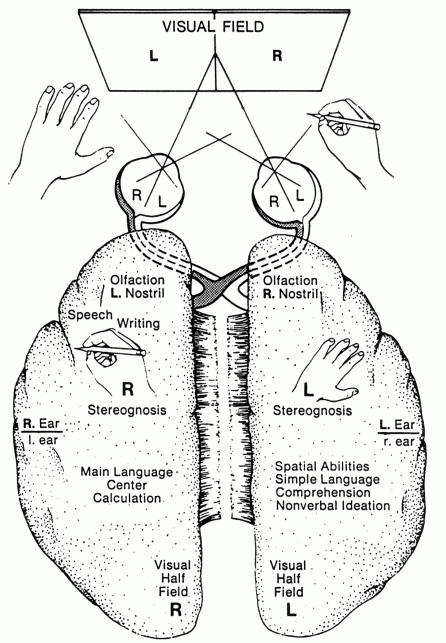
In split-brain patients, the cerebral hemispheres have been separated in order to control epileptic seizures. This separation is accomplished by sectioning two white matter structures that connect the two hemispheres, the corpus callosum and anterior commissure, in a procedure known as corpus callosotomy.
Split-brain patients seem to have two independent conscious selves.
By using them as subjects in experiments, researchers can determine the roles of the two hemispheres.
[Brief note: Because of the retinal connections, an object seen in the left visual field is seen by the right hemisphere independently of the corpus callosum. The corpus callosum, however, is necessary for an object in the left visual field to be seen by the left hemisphere. Thus, in split-brain patients, objects in the left visual field are seen by the right hemisphere and not the left, and objects in the right visual field are seen by the left hemisphere and not the right. This can be seen in the drawing above of a horizontal section, as the R & L in the visual cortex of the respective hemispheres.]
Sperry, Gazzaniga, & Bogen demonstrated the independence of vision and language by presenting visual stimuli to either the right or left visual field of split-brain subjects. When an apple is presented in the right visual field (therefore, seen by the left hemisphere), a split-brain subject will report seeing an apple. However, when an apple is presented in the left visual field (therefore, seen by the right hemisphere), the patient denies having seen it. The patient COULD identify the object with the left hand by pointing to it, and could pick it out from several others by feeling it when it was covered. But he could not name what he saw. He could only identify it through nonverbal means. It seems the right hemisphere cannot talk.
Almost all right-handed people have left-hemisphere speech – meaning, the left-hemisphere is dominant for speech. (Most left-handers also have left-hemisphere speech, but 25% have right-hemisphere speech.) The right hemisphere can recognize very simple language: split-brain patients who see D-O-G with their right hemisphere (left visual field) can select a model of a dog with the left hand. Though it may be mute, the right hemisphere is superior in spatial-perceptual problems (like putting together blocks in a pattern).
-
taken from KSJ, Principles of Neural Science


No comments:
Post a Comment